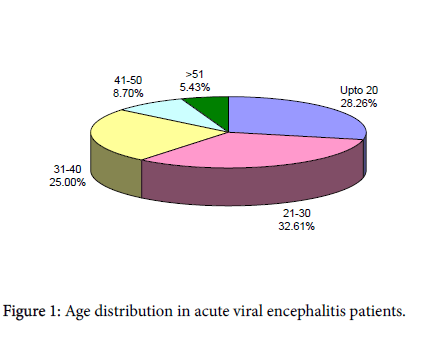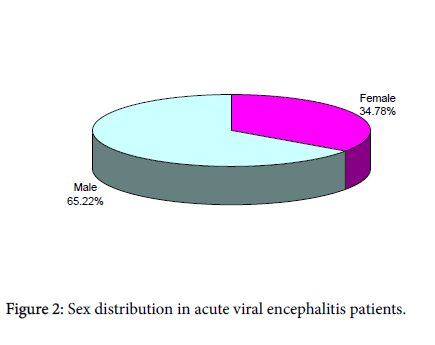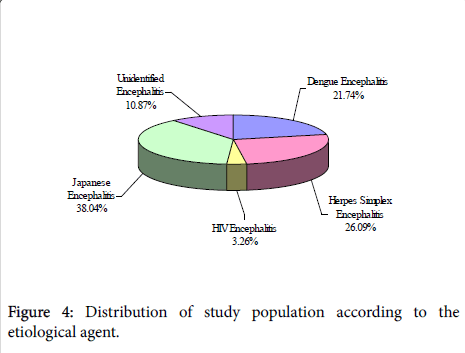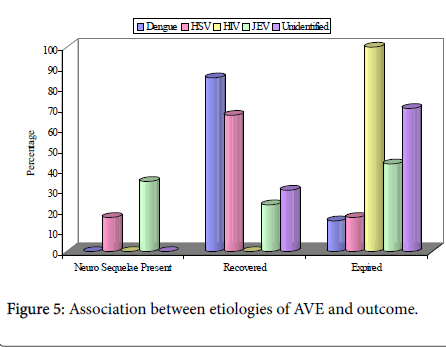Research Article Open Access
The Etiological Diagnosis and Outcome in Patients of Acute Viral Encephalitis: A Prospective Observational Study at Tertiary Care Centre of North India
Deepak Bhagchandani1*, Virendra Atam1, Supriya Thadani2, Kamal Kumar Sawlani1, Isha Atam1 and Anupriya Thadani21Department of Medicine, King George’s Medical University, Lucknow, India
2Department of Pharmacology, Era’s Lucknow Medical College, Lucknow, India
- *Corresponding Author:
- Deepak Bhagchandani
Department of Medicine, King George’s Medical
University Chowk, Lucknow-226003, Uttar Pradesh, India
Tel: 09919125667
E-mail: dbcburns0485@gmail.com
Received date: November 8, 2016; Accepted date: November 28, 2016; Published date: November 30, 2016
Citation: Bhagchandani D, Atam V, Thadani S, Sawlani KK, Atam I, et al. (2016) The Etiological Diagnosis and Outcome in Patients of Acute Viral Encephalitis: A Prospective Observational Study at Tertiary Care Centre of North India. J Neuroinfect Dis 7: 233. doi:10.4172/2314-7326.1000233
Copyright: © 2016 Bhagchandani D, et al. This is an open-access article distributed under the terms of the creative commons attribution license, which permits unrestricted use, distribution, and reproduction in any medium, provided the original author and source are credited.
Visit for more related articles at Journal of Neuroinfectious Diseases
Abstract
Background: Encephalitis, despite being an uncommon entity, is of public health importance worldwide because of its high morbidity and mortality. Around 70% of the disease burden is in Uttar Pradesh itself.
Purpose of study: To study the etiological prevalence and outcome of different viruses as causative agent of acute viral encephalitis in patients reporting to a tertiary health care center in North India.
Methods: All the patients presenting with febrile encephalopathy attending the medicine outdoor patient department or emergency of medicine department were enrolled in the study, of these a total of 92 patients fulfilling the inclusion criteria were included in the study. An informed consent from the patients/their attendants was obtained.
Results: Minimum age of patients was found to be 14 years while maximum age was 61 years. Around 65.22% were males and majority of the patients were from Barabanki (22.83%). Magnetic Resonance Imaging findings were found to be positive in 85.87%. Most common etiology was Japanese encephalitis (38.04%) with human immunodeficiency Virus encephalitis (3.26%) being least common. After a follow up at 1 month, neurological sequelae were found to be highest in Japanese encephalitis while 100% mortality in human immunodeficiency virus encephalitis and recovery was highest in Dengue encephalitis (85.00%). Difference in outcome of different types of encephalitis was found to be statistically significant. Recovery was highest in age group up to 20 years (57.69%). Difference in outcome and age of patients was found to be statistically significant.
Conclusion: Early Reporting, appropriate workup and stabilization of the suspected acute viral encephalitis patients are important so as to reduce the morbidity and mortality.
Introduction
Encephalitis means inflammation of the brain parenchyma derived from the Greek word enkephalon, meaning brain. It is of public health importance worldwide because as it causes high morbidity and mortality. Infection is the most common cause identified, with viruses being an important known etiological agent. Other microorganisms causing encephalitis include protozoans, bacteria including mycobacterium tuberculosis. Unfortunately, we currently lack effective treatment for most encephalitic viral agents identified so far [1]. Confirmation of the diagnosis requires exclusion of both metabolic, toxic encephalopathy and inflammatory encephalitis of non-infectious origin [2].
It has been estimated that around 70% of the disease burden is present in Uttar Pradesh itself. Jain et al. reported that in the year 2012, 3494 patients suffering from acute encephalitic syndrome (AES) were admitted to government hospitals in Gorakhpur and Basti and 588 of who died. There is an approximate annual incidence of 10% to 15% of AES in Uttar Pradesh itself [3]. The state of Uttar Pradesh has experienced periodic AES outbreaks since 1978, but following a major outbreak in 2006, the annual case load has exceeded 3,000 patients, three times the level prior to that year. The state has accounted for almost half (over 20,000) of cases and 3,560 deaths since 2008. Only 8.1% of the cases have been confirmed for Japanese encephalitis (JE) and the state has annually hosted a variety of investigative teams [3].
Hence, a better understanding of the epidemiology of this devastating disease will pave the way for better prevention and planning of control strategies. The inventory of viruses responsible for encephalitis is not exhaustive, with gaps depending on the strategy or standardized procedures used for virus identification and the tools available for diagnosis. Sharma et al. highlighted the problems that were encountered during the management of suspected cases of viral encephalitis. These included paucity of data about the regional epidemiology and etiology of viral encephalitis, lack of easily available, low-cost microbiological testing for agents of viral encephalitis, lack of specific treatments for majority of the etiological agents, high incidence of mimickers-pyogenic meningitis, cerebral malaria, tubercular meningitis, acute disseminated encephalomyelitis, lack of facilities for intensive care in the periphery, lack of facilities for neuroimaging in the periphery, inappropriate response during epidemics-what samples to take, how to store, whom to inform, patient delay in seeking health care, delay/not performing lumbar punctures and inappropriate supportive care [4].
Methods
This prospective observational study was conducted in the department of medicine, King George’s medical college, Lucknow for one year after the approval from the Institutional Ethical Committee A written informed consent was taken from all the patients’ guardians and thereafter patients were included in the study after explaining the procedure of the study.
Inclusion criteria
Patients aged more than 13 years of either sex presenting with febrile encephalopathy were included in the study.
Exclusion criteria
Patients diagnosed with pyogenic meningitis, tuberculous meningitis, septicaemia associated encephalopathy, non-infectious encephalopathy and those who refused to give consent were excluded from the study.
Detailed history with recording of the patient’s particulars was done. The investigations included complete blood counts, kidney function test, liver function test, serum electrolytes, chest skiagram, ultrasound whole abdomen, sputum for Acid Fast Bacilli, Human Immunodeficiency Virus-Enzyme linked immunosorbent assay (HIVELISA), Computed Tomography (CT) Scan head, Magnetic resonance imaging (MRI) of brain. Detailed cerebrospinal fluid analysis was done. Patients were reassessed after 1 month so as to study the outcome in form of recovery, expiry and neurological sequelaes in different etiologies of acute viral encephalitis.
All the patients were managed conservatively in form of intravenous fluids, intravenous antibiotics and anti-viral agent. Patients were assessed at 1 month of follow-up after discharge so as to study the outcome in form of recovery, expiry and persistent neurological sequelaes in different etiologies of acute viral encephalitis. The patients were thus examined for improvement or deterioration in condition with special attention to neurological assessment.
Statistical Analysis
Data was recorded in Microsoft excel 2003. The results were presented as mean ± Standard deviation (SD), median, and percentages. Chi-square test was used to compare the categorical/ dichotomous variables. A P value of <0.05 was considered statistically significant. All the analysis was carried out using SPSS (Statistical Package for the social sciences) 16.0 software.
Results
All the patients presenting with febrile encephalopathy attending the medicine outdoor patient department (OPD) or emergency of medicine department were enrolled in the study, of these a total of 92 patients fulfilling the inclusion criteria and not coming under the domain of exclusion criteria were included in the study.
Figure 1 shows the distribution of Study Population according to age (Range of age: 14-61; Median: 26.00; Mean ± SD: 28.45+10.93 years).
Minimum age of patients included in the study was found to be 14 years while maximum age was found to be 61 years. Median age was 26 years while mean age was 28.45+10.93 years. Majority of the patients were aged upto 30 years (n=56; 60.87%) rest 46 patients were aged >39 years (39.13%). Higher prevalence was found in 21-30 years (32.61%) followed by Upto 20 years (28.26%), 31-40 years (25.00%), 41-50 years (8.70%) and only 5 (5.43%) patients were aged >51 years.
Figure 2 shows the distribution of study population according to gender.
This figure indicates that the prevalence of acute viral encephalitis was higher among males with male:female ratio of 1:0.53.
Majority of the patients were from Barabanki (22.83%), Lucknow (20.65%) and Gorakhpur (19.57%) followed by Basti (6.52%), Faizabad (4.35%) and Kanpur (3.26%). MRI findings were found to be positive in majority of the patients (n=79; 85.87%) (Table 1).
| MRI Findings | Number of patients | Percentage |
|---|---|---|
| Positive | 79 | 85.87 |
| Negative | 13 | 14.13 |
| Total | 92 | 100 |
Table 1: Distribution of study population according to MRI Findings.
The detection of the cerebrospinal fluid (CSF) viral markers in form of polymerase chain reaction (PCR) and ELISA was highest in that of Japanese encephalitis (22.83%) followed by Herpes simplex virus encephalitis (13.04%), dengue encephalitis (7.61%) and HIV encephalitis(3.26%) whereas no specific viral marker could be identified in 9.78% (Figure 3).
Most common etiology was Japanese encephalitis virus (38.04%) followed by Herpes Simplex virus (HSV) (26.09%), Dengue virus (21.74%), Unexplained etiology (10.87%) while least common was HIV (3.26%) (Figure 4).
Though proportional difference in age of patients with different diagnosis of encephalitis was found but this difference was not found to be statistically significant (χ²=11.081 (df=16); p=0.804).
In all the types of encephalitis, prevalence was higher in males (70%) as compared to females (30%). All the patients of HIV Encephalitis were males. No statistically significant association of gender with different etiology of encephalitis was found (χ²=3.041(df=4); p=0.551).
After a follow up at 1 month, neuro-sequelae were found to be present in 4 (16.67%) subjects of HSV encephalitis and in 12 (34.29%) subjects of Japanese encephalitis. All the patients of HIV encephalitis (n=3; 100.0%) expired after a follow up of 1 month. Proportion of patients who recovered was higher for Dengue (n=17; 85.00%) and HSV Encephalitis (n=16; 66.67%) as compared to Japanese encephalitis (n=8; 22.86%) and Unidentified type of encephalitis (30.0%). Difference in outcome of different types of encephalitis was found to be statistically significant (χ²=38.117(df=8); p<0.001) (Figure 5).
Proportion of recovery in patients of encephalitis was found to be higher in age group Upto 20 years (57.69%) and age group 21-30 years (53.33%) as compared to patients aged >50 years (40.00%), 31-40 years (26.09%) and 41-50 years (25.00%). Expiry rate was higher patients aged >31 years as compared to those in Upto 30 years. Rate of expiry was found to be higher in 41-50 years age (67.50%), >51 years (60.0%) and in 31-40 years (52.17%) as compared to age Upto 20 years (26.92%), 21-30 years (26.67%). Difference in outcome and age of patients was found to be statistically significant as shown in Table 2. (χ²=38.117(df=8); p<0.001).
Discussion
Epidemic outbreaks of viral encephalitis pose a significant public health problem in the densely-populated regions of tropical and subtropical Asia. Over decades, several epidemics have occurred and there are evidences suggesting that the disease has spread to newer areas.
In our study, the mean age of patients was 28.45+10.93 years. Minimum age of patients included in the study was found to be 14 years while maximum age was found to be 61 years. Majority of the patients belonged to the 21-30-year age group category (32.61%), followed by upto 20-year age category (28.26%). Only 5.43% patients belonged to the above 50 year age group category. This shows that febrile encephalopathy (including viral encephalitis) affects the young age group more than the elderly population which may lead to lifelong morbidity or even mortality. Jain et al. reported that the mean age group of patients suffering from AES was 11 years (range of 1-70 years) [3].
No statistically significant association of outcome and gender was found.
65.22% were males and rest 34.78% were females, which indicate that the prevalence of acute viral encephalitis was higher in males as compared to females. Slightly higher preponderance in males may be due to more environmental exposure. Previous reports and recent analyses clearly indicate that in general men are more prone to JE infection than women, which could be attributed to more outdoor activity by the male population during the peak biting time of exophilic vectors and more exposed body parts, especially the lower extremities, to mosquito bites, while women tend to be fully covered by dresses. Our results are in conformity with that of Jain et al. who reported AES in 544 (34.5%) female patients, while the remaining (65.5%) were males [3].
According to Kumari et al. outbreak in UP reported a case breakdown of 61% males and 39% females (deaths attributed to disease were 59% in males and 41% in females) [5].
Majority of the patients (n=58; 63.04%) were from Lucknow (20.63%), Barabanki (22.83%) and Gorakhpur (19.57%). Jain et al. reported maximum cases in Sitapur (84.7%), followed by Basti (76.4%), Gonda (76.1%), Hardoi (73%)3. Only 46.2% cases were reported from Lucknow in their study. Although mass vaccination program against JEV has been launched by the Government of India in highly endemic districts of UP in 2006, and further expanded in the subsequent years, the current prevalence of viral encephalitis, especially JE, shows the low vaccination coverage and inadequacy of the program. This could also be attributed to the changes in the genotype of the circulating trains.MRI findings were found to be positive in majority of the patients (n=79; 85.87%), in rest 13 (14.13%) patients MRI findings were not found to be positive.
MRI findings were found to be positive in majority of the patients (n=79; 85.87%), in rest 13 (14.13%) patients MRI findings were not found to be positive.
Though proportional difference in age of patients with different diagnosis of encephalitis was found but this difference was not found to be statistically significant. No statistically significant association of Age and different diagnosis of encephalitis was found (p=0.804). Jain et al. however reported that JEV most commonly affected children aged between 5 and 15 years, while DV infection mostly affected children aged between 1 and 5 years 3. No child in their study of less than 1 year age group was affected by HSV, while all other age groups were almost equally affected. Mumps was most commonly seen in young adults (15-150 years of age), while measles was seen in 1-5 year age group.
After a follow up at 1 month, neuro-sequelae was found to be present in 4 (16.67%) subjects of HSV encephalitis and in 12 (34.29%) subjects of Japanese encephalitis. All the patients of HIV encephalitis (n=3; 100.0%) expired after a follow up of 1 month. Proportion of patients who recovered was higher for Dengue (n=17; 85.00%) and HSV Encephalitis (n=16; 66.67%) as compared to Japanese encephalitis (n=8; 22.86%) and Unidentified type of encephalitis (30.0%). Difference in outcome of different types of encephalitis was found to be statistically significant. To the best of our knowledge, no study has yet been done that addresses both the etiological diagnosis as well as the outcome of those patients in North India, and our study is the first to report this. The study conducted by Jain et al. showed that maximum mortality was caused by JEV, while HSV was the leading cause of residual neurological disability 3. Of the 39 HSV-positive patients with residual illness, 21 (53.8%) patients had intermittent seizures, while 18 (46.2%) patients had behavioral disturbances. Similarly, 3 out of 7 mumps virus positive patients with residual illness, 3 were ataxic, 3 developed transverse myelitis, while 1 displayed behavioral disturbances.
In the study conducted by Rao et al. on 24 dengue, encephalitic patients, 22 patients recovered completely (independent for activities of daily living), and 2 patients died (due to severe sepsis with MODS) [6]. Singh et al. prospective observational study explored the independent predictors of adverse outcome in the patients with confirmed/probable viral encephalitis [7]. The primary outcome variable was the incidence of adverse outcomes defined as death or severe neurological deficit such as loss of speech, motor deficits, behavioral problems, blindness, and cognitive impairment. Their study highlighted the association between under nutrition and adverse outcome in confirmed/probable viral encephalitis cases.
Our results are further supported by the study of Whitley et al. in which nearly half of the patients who survived HSV encephalitis had a neurological impairment six months after the completion of antiviral therapy [8].
Proportion of recovery in patients of encephalitis was found to be higher in age group upto 20 years (57.69%) and age group 21-30 years (53.33%) as compared to patients aged >50 years (40.00%), 31-40 years (26.09%) and 41-50 years (25.00%). Expiry rate was higher patients aged >31 years as compared to those in upto 30 years. Rate of expiry was found to be higher in 41-50 years age (67.50%), >51 years (60.0%) and in 31-40 years (52.17%) as compared to age upto 20 years (26.92%), 21-30 years (26.67%). Difference in outcome and age of patients was found to be statistically significant.
No statistically significant association of outcome and gender was found.
The current study was time limited ranging for a period of around 12 months only. It was focused mainly on the patients presenting to the tertiary care hospital of North India. A limited number of etiologic agents were tested, which did not include non-viral causative agents of AES.
Conclusion
Early stabilization and institution of non-specific supportive measures is the cornerstone of management. Reporting and appropriate workup of the suspected acute viral encephalitis patients is important so as to reduce the morbidity and mortality.
References
- Stahl JP, Mailles A, Morand P (2011) Viral Encephalitis in 2010: From epidemiology to treatment. Infect Disord Drug Targets.
- Du Pasquier R, Meylan P, Kaiser L, Lalive PH (2009) Viral encephalitis: update. Rev Med Suisse 5: 96870-96873.
- Jain P, Jain A, Kumar A, Prakash S, Khan DN, et al. (2014) Epidemiology and etiology of acute encephalitis syndrome in North India. Japanese J Infec Dis 67: 197-203.
- Sharma S, Mishra D, Aneja S, Kumar R, Jain A, et al. (2012) Consensus guidelines on evaluation and management of suspected acute viral encephalitis in children in India. Indian Pediatr 49: 897-910.
- Kumari R, Joshi PL (2012) A review of Japanese encephalitis in Uttar Pradesh, India. WHO South-East Asia J Public Health 1: 374-395.
- Rao SM, Pradeep M, Dnyaneshwar M, Alai T (2013) Dengue encephalitis-clinical spectrum and outcome. Intern Med Inside 1: 1-8.
- Singh KP, Mishra G, Jain P, Pandey N, Nagar R, et al. (2013) Co-positivity of anti-dengue virus and anti-Japanese encephalitis virus IgM in endemic area: Co-infection or cross reactivity? Asian Pacific J Trop Med 412-420.
- Whitley RJ, Lakeman F (1995) Herpes simplex virus infections of the central nervous system: therapeutic and diagnostic considerations. Clin Infect Dis 20: 414-420.
Relevant Topics
- Bacteria Induced Neuropathies
- Blood-brain barrier
- Brain Infection
- Cerebral Spinal Fluid
- Encephalitis
- Fungal Infection
- Infectious Disease in Children
- Neuro-HIV and Bacterial Infection
- Neuro-Infections Induced Autoimmune Disorders
- Neurocystercercosis
- Neurocysticercosis
- Neuroepidemiology
- Neuroinfectious Agents
- Neuroinflammation
- Neurosyphilis
- Neurotropic viruses
- Neurovirology
- Rare Infectious Disease
- Toxoplasmosis
- Viral Infection
Recommended Journals
Article Tools
Article Usage
- Total views: 4313
- [From(publication date):
December-2016 - Aug 29, 2025] - Breakdown by view type
- HTML page views : 3326
- PDF downloads : 987





